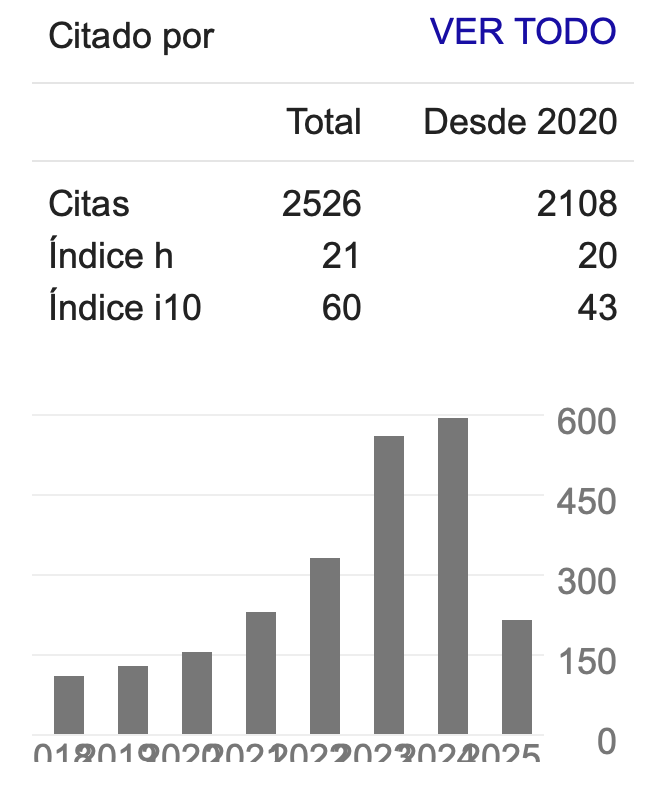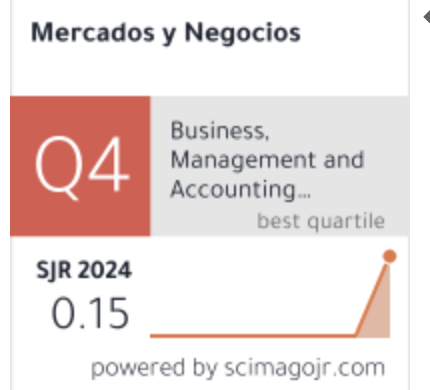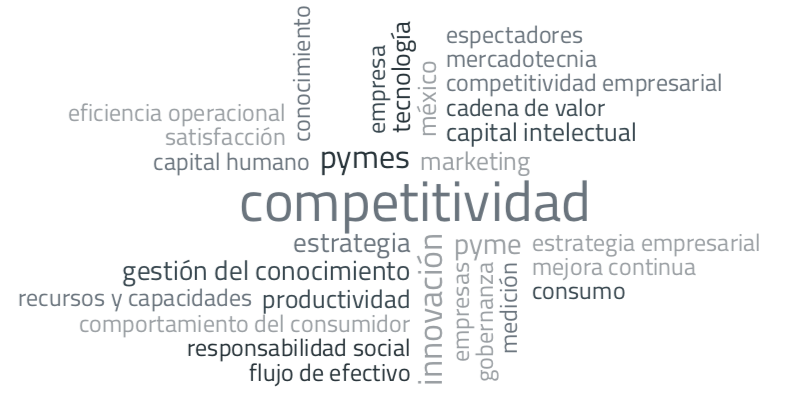La influencia de las tic y la innovación en el rendimiento de las pymes de Aguascalientes: una evidencia empírica
DOI:
https://doi.org/10.32870/myn.v0i23-24.5164Keywords:
tic, innovación, rendimiento, pymes.Abstract
El nuevo ambiente de los negocios exige a las organizaciones un redireccionamiento en sus estrategias, para adecuarlas al nuevo entorno empresarial que presenta un mercado cada vez más globalizado y competitivo. Así, las tecnologías de la información y comunicación (tic) y la innovación surgen como dos elementos esenciales que deben ser incorporados en las estrategias empresariales, y son dos factores que permiten mejorar el rendimiento de las empresas, principalmente de las pymes. En este sentido, este estudio con una muestra de 400 empresas analiza los efectos de las tic y la innovación en el rendimiento de las pymes de Aguascalientes. Los resultados obtenidos muestran, por un lado, que las tic ejercen un efecto positivo en la innovación de las empresas y, por otro, tanto las tic como la innovación ejercen un efecto positivo en el rendimiento de las pymes.References
Achrol, R. S., & Kotler, P. (1999). Marketing in the network economy. The Journal of Marketing, 146-163.
de de Contabilidad, A. E., & de Empresas, A. (1995). La innovación en la empresa: factor de supervivencia. Principios de organización y sistemas.
García Pérez de Lema, D. (2005). Estrategia e innovación de la pyme industrial en España. AECA. Madrid.
Ahuja, G. (2000). Collaboration networks, structural holes, and innovation: A longitudinal study. Administrative science quarterly, 45(3), 425-455.
Aral, S., & Weill, P. (2007). IT assets, organizational capabilities, and firm performance: How resource allocations and organizational differences explain performance variation. Organization Science, 18(5), 763-780.
Arndt, S. W., & Kierzkowski, H. (Eds.). (2001). Fragmentation: New production patterns in the world economy. OUP Oxford.
Bangemann, M. (1994). Recommendations to the European Council: Europe and the global information society. Brussels: European Commission.
Barba-Sánchez, V., del Pilar Martínez-Ruiz, M., & Jiménez-Zarco, A. I. (2007). Drivers, benefits and challenges of ICT adoption by small and medium sized enterprises (SMEs): a literature review. Problems and Perspectives in Management, 5(1), 103.
Bhaskaran, S. (2006). Incremental innovation and business performance: small and medium‐size food enterprises in a concentrated industry environment.Journal of Small Business Management, 44(1), 64-80.
Blumentritt, T., & Danis, W. M. (2006). Business strategy types and innovative practices. Journal of Managerial Issues, 274-291.
Brady, M., Saren, M., & Tzokas, N. (2002). Integrating information technology into marketing practice–the IT reality of contemporary marketing practice.Journal of Marketing Management, 18(5-6), 555-577.
Brown, S., & Bessant, J. (2003). The manufacturing strategy-capabilities links in mass customisation and agile manufacturing-an exploratory study.International Journal of Operations & Production Management, 23(7), 707-730.
Carbonara, N. (2005). Information and communication technology and geographical clusters: opportunities and spread. Technovation, 25(3), 213-222.
Carroll, G. R., & Mosakowski, E. (1987). The career dynamics of self-employment. Administrative science quarterly, 570-589.
Cela, J. R. (2005). Sociedad del conocimiento y sociedad global de la información: Implantación y desarrollo en España/Knowledge Society and Global Society of Information: Implantation and Development in Spain.Documentación de las Ciencias de la Información, 28, 147.
Chapman, P., James-Moore, M., Szczygiel, M., & Thompson, D. (2000). Building internet capabilities in SMEs. Logistics Information Management,13(6), 353-361.
Connell, J., Edgar, G. C., Olex, B., Scholl, R., Shulman, T., & Tietjen, R. (2001). Troubling successes and good failures: Successful new product development requires five critical factors. Engineering Management Journal,13(4), 35-39.
Corbitt, B. J. (2000). Developing intraorganizational electronic commerce strategy: An ethnographic study. Journal of Information Technology, 15(2), 119-130.
Daniel, E., Wilson, H., & Myers, A. (2002). Adoption of E-Commerce by SMEs in the UK towards a stage model. International Small Business Journal, 20(3), 253-270.
Das, S. R., Zahra, S. A., & Warkentin, M. E. (1991). Integrating the content and process of strategic MIS planning with competitive strategy. Decision sciences, 22(5), 953-984.
de Lema, D. G. P. (2007). Relación entre las TIC y la rentabilidad empresarial. Evidencia empírica. In Las competencias profesionales relacionadas con las TIC y el espíritu emprendedor (pp. 139-154). Ministerio de Educación.
Devaraj, S., & Kohli, R. (2003). Performance impacts of information technology: Is actual usage the missing link?. Management science, 49(3), 273-289.
Dibrell, C., Davis, P. S., & Craig, J. (2008). Fueling innovation through information technology in SMEs. Journal of small business management,46(2), 203-218.
Fiol, C. M. (1996). Squeezing harder doesn't always work: Continuing the search for consistency in innovation research. Academy of Management Review, 21(4), 1012-1021.
Freeman, C. (1974). Innovation and the strategy of the firm. C. Freeman, The Economics of Industrial Innovation, Penguin Books Ltda., Harmondsworth.
Frishammar, J., & Åke Hörte, S. (2005). Managing external information in manufacturing firms: The impact on innovation performance. Journal of Product Innovation Management, 22(3), 251-266.
García, D., Martínez, M., & Maldonado, G. (2009). Innovación y Cultura Empresarial de la MiPyME del Estado de Aguascalientes. México DF: Universidad Autónoma de Aguascalientes.
Garcia, R., & Calantone, R. (2002). A critical look at technological innovation typology and innovativeness terminology: a literature review. Journal of product innovation management, 19(2), 110-132.
Gatignon, H., & Xuereb, J. M. (1997). Strategic orientation of the firm and new product performance. Journal of marketing research, 77-90.
Graham, S., & Marvin, S. (2001). Splintering urbanism: networked infrastructures, technological mobilities and the urban condition. Psychology Press.
Hansen, M. T. (1999). The search-transfer problem: The role of weak ties in sharing knowledge across organization subunits. Administrative science quarterly, 44(1), 82-111.
Homburg, C., Hoyer, W. D., & Fassnacht, M. (2002). Service orientation of a retailer’s business strategy: Dimensions, antecedents, and performance outcomes. Journal of Marketing, 66(4), 86-101.
Huang, G. Q., & Mak, K. L. (1999). Current practices of engineering change management in UK manufacturing industries. International Journal of Operations & Production Management, 19(1), 21-37.
Hughes, A. (2001). Innovation and business performance: small entrepreneurial firms in the UK and the EU. New Economy, 8(3), 157-163.
Hult, G. T. M., Hurley, R. F., & Knight, G. A. (2004). Innovativeness: Its antecedents and impact on business performance. Industrial marketing management, 33(5), 429-438.
Hyland, P. W., Marceau, J., & Sloan, T. R. (2006). Sources of innovation and ideas in ICT firms in Australia. Creativity and Innovation Management, 15(2), 182-194.
Javalgi, R., & Ramsey, R. (2001). Strategic issues of e-commerce as an alternative global distribution system. International marketing review, 18(4), 376-391.
Kinder, T. (2002). Emerging e-commerce business models: an analysis of case studies from West Lothian, Scotland. European Journal of Innovation Management, 5(3), 130-151.
Leenders, M. A., & Wierenga, B. (2002). The effectiveness of different mechanisms for integrating marketing and R&D. Journal of product innovation management, 19(4), 305-317.
Levesque, M., & Minniti, M. (2006). The effect of aging on entrepreneurial behavior. Journal of Business Venturing, 21(2), 177-194.
Lewis, M. W., Welsh, M. A., Dehler, G. E., & Green, S. G. (2002). Product development tensions: Exploring contrasting styles of project management.Academy of Management Journal, 45(3), 546-564.
Lockett, N., Brown, D. H., & Kaewkitipong, L. (2006). The use of hosted enterprise applications by SMEs: a dual market and user perspective.Electronic Markets, 16(1), 85-96.
Madrid‐Guijarro, A., Garcia, D., & Van Auken, H. (2009). Barriers to innovation among Spanish manufacturing SMEs. Journal of Small Business Management,47(4), 465-488.
Malone, T. W., Yates, J., & Benjamin, R. I. (1987). Electronic markets and electronic hierarchies. Communications of the ACM, 30(6), 484-497.
Manu, F. A. (1992). Innovation orientation, environment and performance: A comparison of US and European markets. Journal of International Business Studies, 23(2), 333-359.
Manu, F. A., & Sriram, V. (1996). Innovation, marketing strategy, environment, and performance. Journal of business Research, 35(1), 79-91.
Martin, L. M., & Matlay, H. (2001). “Blanket” approaches to promoting ICT in small firms: some lessons from the DTI ladder adoption model in the UK.Internet research, 11(5), 399-410.
Mehrtens, J., Cragg, P. B., & Mills, A. M. (2001). A model of Internet adoption by SMEs. Information & management, 39(3), 165-176.
Oyelaran-Oyeyinka, B., & Lal, K. (2006). Learning new technologies by small and medium enterprises in developing countries. Technovation, 26(2), 220-231.
Peppard, J., & Ward, J. (2003). Strategic planning for information systems. John Wiley & Sons Incorporated.
Productivity Commission. (2005). ICT use and productivity: A synthesis from studies of Australian firms. SSRN Working Paper Series.
Ramsey, E., Ibbotson, P., Bell, J., & Gray, B. (2004). A projectives perspective of international “e”-services. Qualitative Market Research: An International Journal, 7(1), 34-47.
Rangaswamy, A., & Lilien, G. L. (1997). Software tools for new product development. Journal of Marketing Research, 34(1), 177-184.
Ray, G., Muhanna, W. A., & Barney, J. B. (2005). Information technology and the performance of the customer service process: A resource-based analysis.MIS quarterly, 625-652.
Roberts, J. (2000). From know-how to show-how? Questioning the role of information and communication technologies in knowledge transfer. Technology Analysis & Strategic Management, 12(4), 429-443.
Saarenketo, S., Puumalainen, K., Kyläheiko, K., & Kuivalainen, O. (2008). Linking knowledge and internationalization in small and medium-sized enterprises in the ICT sector. Technovation, 28(9), 591-601.
Sammut-Bonnici, T., & McGee, J. (2002). Network strategies for the new economy. European Business Journal, 14, 174-185.
Segarra, A. (2002). Creación y supervivencia de empresas. XVII Jornadas de Alicante Sobre Economía Española, Alicante, Spain.
Sørensen, J. B. (2007). Closure and exposure: Mechanisms in the intergenerational transmission of self-employment. Research in the Sociology of Organizations, 25(83), 124.
Stare, M., Jaklič, A., & Kotnik, P. (2006). Exploiting ICT potential in service firms in transition economies. The Service Industries Journal, 26(03), 287-302.
Sullivan, O. (1997). Time waits for no (wo) man: An investigation of the gendered experience of domestic time. Sociology, 31(2), 221-239.
Troy, L. C., Szymanski, D. M., & Varadarajan, P. R. (2001). Generating new product ideas: An initial investigation of the role of market information and organizational characteristics. Journal of the Academy of Marketing Science,29(1), 89-101.
Walker, R. M. (2005, August). INNOVATION AND ORGANIZATIONAL PERFORMANCE: A CRITICAL REVIEW OF THE EVIDENCE AND A RESEARCH AGENDA. In Academy of Management proceedings (Vol. 2005, No. 1, pp. B1-B6). Academy of Management.
Wolff, J. A., & Pett, T. L. (2006). Small‐firm performance: modeling the role of product and process improvements. Journal of Small Business Management,44(2), 268-284.
Worren, N., Moore, K., & Cardona, P. (2002). Modularity, strategic flexibility, and firm performance: a study of the home appliance industry. Strategic management journal, 23(12), 1123-1140.
Downloads
Published
How to Cite
Issue
Section
License
Mercados y Negocios by Department of Mercadotecnia y Negocios Internacionales. University of Guadalajara is licensed under a License Creative Commons Attribution-NonCommercial 4.0 International.
The author retains the copyright.








